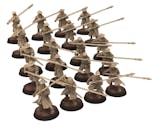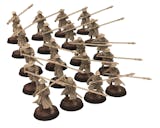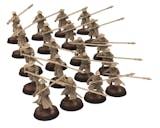Printed in solid non-hollowed resin (no holes).
Good quality resin (40€/kg).
Bases not supplied.
Randomly packaged.
28mm scale (for SDA/D&D).
These models were made by Medbury miniatures and are sold under license.
https://www.patreon.com/medburyminiatures/posts
The Scottish pikemen of the 14th century were renowned for their formidable presence on the medieval European battlefield. Clad in sturdy armor and armed with long pikes, they formed the backbone of many Scottish armies during this period. These pike formations played a crucial role in shaping the outcome of battles, as they were able to withstand the charges of heavily armored knights and deliver devastating blows with their long weapons.
The pike, a long spear-like weapon, became a popular choice among medieval infantry due to its reach and defensive capabilities. Pikes could measure up to 18 feet in length, allowing pikemen to keep enemy forces at a distance and create a formidable barrier. The Scots, in particular, embraced the use of pikes and developed tactical formations that maximized their effectiveness on the battlefield.
The Scottish pikemen were well-trained and disciplined soldiers. They would form tight formations called schiltrons, which consisted of multiple ranks of pikemen standing shoulder to shoulder, presenting a wall of deadly points to their enemies. This formation provided mutual protection and made it difficult for enemy cavalry charges to break through their ranks.
In addition to their pikes, Scottish pikemen often carried secondary weapons such as swords or poleaxes for close combat. This versatility allowed them to adapt to different situations on the battlefield, whether engaging in direct melee or fending off cavalry attacks. Their skill in wielding these weapons, coupled with their discipline and determination, made them a formidable force.
The use of pike formations was not exclusive to the Scottish armies. Throughout medieval Europe, pike formations became a common sight on battlefields. Nations such as England, France, and Germany also employed pikemen as a vital component of their armies. Pike formations provided a cost-effective way to counter heavy cavalry charges and allowed infantry to hold their ground against superior numbers.
Pikemen played a significant role in many medieval battles, such as the Battle of Bannockburn in 1314, where Scottish pikemen under the command of King Robert the Bruce successfully repelled English forces. Their disciplined formations and unwavering resolve proved instrumental in securing victory.
In the world of wargaming, recreating the iconic Scottish pikemen or generic medieval pikemen on the tabletop is a thrilling experience. Miniatures depicting these warriors allow players to immerse themselves in the tactics and strategies of medieval warfare. The attention to detail in these miniatures brings to life the intricacies of pike formations and the distinctive appearance of these warriors.
Whether recreating historical battles or exploring fictional worlds inspired by medieval settings, having a collection of miniature Scottish pikemen or medieval pikemen is a must for any wargaming enthusiast. Their presence on the tabletop adds depth and authenticity to the gaming experience, allowing players to relive the glory and challenges of medieval warfare.
In conclusion, the Scottish pikemen of the 14th century and their medieval counterparts were formidable warriors who played a crucial role in shaping the outcome of battles. Their disciplined formations, deadly pikes, and unwavering resolve made them a force to be reckoned with on the battlefield. Capturing the spirit of these warriors through miniature figures brings the excitement of medieval warfare to wargaming enthusiasts worldwide.























